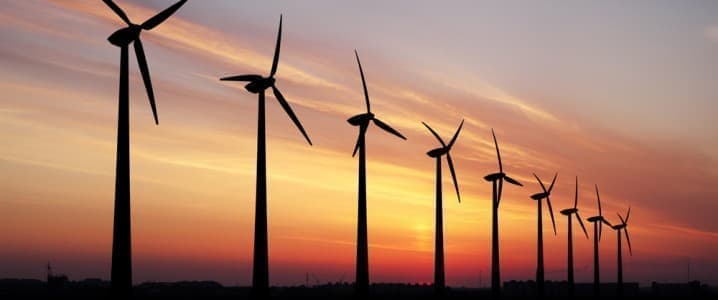You can win a million dollars for finding a solution to reliably predict how air currents, breeze, and turbulence interact in a mathematical model of fluid dynamics. The $1 million Millennium Prize is offered for solving equations like the Navier–Stokes Equation, first formulated in the 19th century, but never solved. The prize is so substantial not only because a thorough understanding of the remarkable complexities of fluid dynamics has remained far out of reach for mathematicians, but also because of the major implications that such a model would have on atmospherically-reliant technologies such as wind power.
In its simplest form, wind power works like this: the wind blows, a turbine spins, a generator is rotated, and energy is thereby produced. But the reality is much more complicated. Turbulence messes up all of those straightforward understandings of wind + turbine = energy. Not only can it decrease the amount of power produced on any given day, but the wind that blows through a group of turbines can even strip away energy from the wind farm, all depending on the unpredictable element of turbulence.
Currently (no pun intended), our relatively rudimentary understanding of fluid dynamics poses a major challenge to the efficacy and efficiency of wind power production. The better we can understand and account for the intricacies of wind and weather, the better we can design wind turbines and wind farms. When a recent study published in the scientific journal Physics applied more complicated atmospheric conditions (such as reduced wind at high altitudes) to their model than the more simplistic ones that are typically used, researchers found that the power output of some turbines dropped by as much as 30%.
The more complicated, and therefore more realistic atmospheric wind model used in the Physics experiment “adds vertical pressure gradients that disturb the simplified wind band at prop height and decrease wind at higher altitudes,” wrote Big Think, translating the article into layman’s terms. “The simulations show that this drives down the velocity of the incoming wind jet and creates turbulence that slows the horizontal flow driving the blades. However, the turbulence doesn’t bring down enough air flow from above the propellors to compensate for the loss in horizontal speed it causes.” With the inclusion of these factors that more accurately reflect real-world atmospheric conditions, projected output dropped by up to 30%.
And we still have to consider the fact that these “more realistic” models are still not based in mathematically reliable fluid dynamics modeling. Because, of course, it doesn’t exist. “Wind farms may produce less power than we expect for all kinds of reasons that can’t be revealed by our simplified modeling of atmospheric fluid dynamics,” Big Think writes. Indeed, atmospheric modeling still has a long, long way to go before we can truly take full advantage of wind farms.
Improving the efficiency of wind farms could be a key step toward meeting global climate goals. The globally recognized Net Zero Emissions by 2050 Scenario includes the benchmark of approximately 7900TWh of wind electricity generation worldwide in 2030. To get on track with this Scenario, according to the International Energy Agency, the world would have to increase average annual wind power capacity additions to almost 250GW, a more than two-fold increase of the previous record for annual addition.
While adding more wind turbines is the focus of such a scenario, improving the efficiency of wind power through a better understanding of fluid dynamics could be a game changer for the industry. It’s becoming increasingly clear that the need for rapid, massive-scale addition of renewable energy is at loggerheads with other global development needs, such as increasing demand on land for agriculture. In fact, land use competition and disagreements have already been a major roadblock for clean energy development in the United States. A recent analysis from global management consulting firm McKinsey & Company reported that “utility-scale solar and wind farms require at least ten times as much space per unit of power as coal- or natural gas–fired power plants, including the land used to produce and transport the fossil fuels,” and that “wind turbines are often placed half a mile apart,” giving wind farms a massive footprint. Increasing the efficacy of the turbines through better atmospheric modeling could therefore be a win-win for energy production and efficient land use.
By Haley Zaremba for Oilprice.com
More Top Reads From Oilprice.com:
- Top 10 Countries With Largest Oil Reserves
- Fuel Smuggling Out Of Iran Is Thriving
- What Happened To Oil & Gas Dealmaking In The First Quarter?



















However, this isn’t the only problem facing wind and also solar power: intermittency and storage.
The notions of a total or imminent global energy transition into renewables and net-zero emissions are myths. Even a partial transition to renewables won’t succeed without major contributions from natural gas and to some extent nuclear power and coal. The reason is the intermittent nature of renewables.
Today’s technology won’t allow us to save solar electricity generated in summer for use in winter because of lack of enough battery storage.
The intermittent wind and solar energy is incapable on its own of solving today’s energy problems. This in no way means that they can't contribute significantly to global energy needs.
Dr Mamdouh G Salameh
International Oil Economist
Global Energy Expert